MARIANI’SVirtual
Gourmet
AUGUST 24,
2014
NEWSLETTER
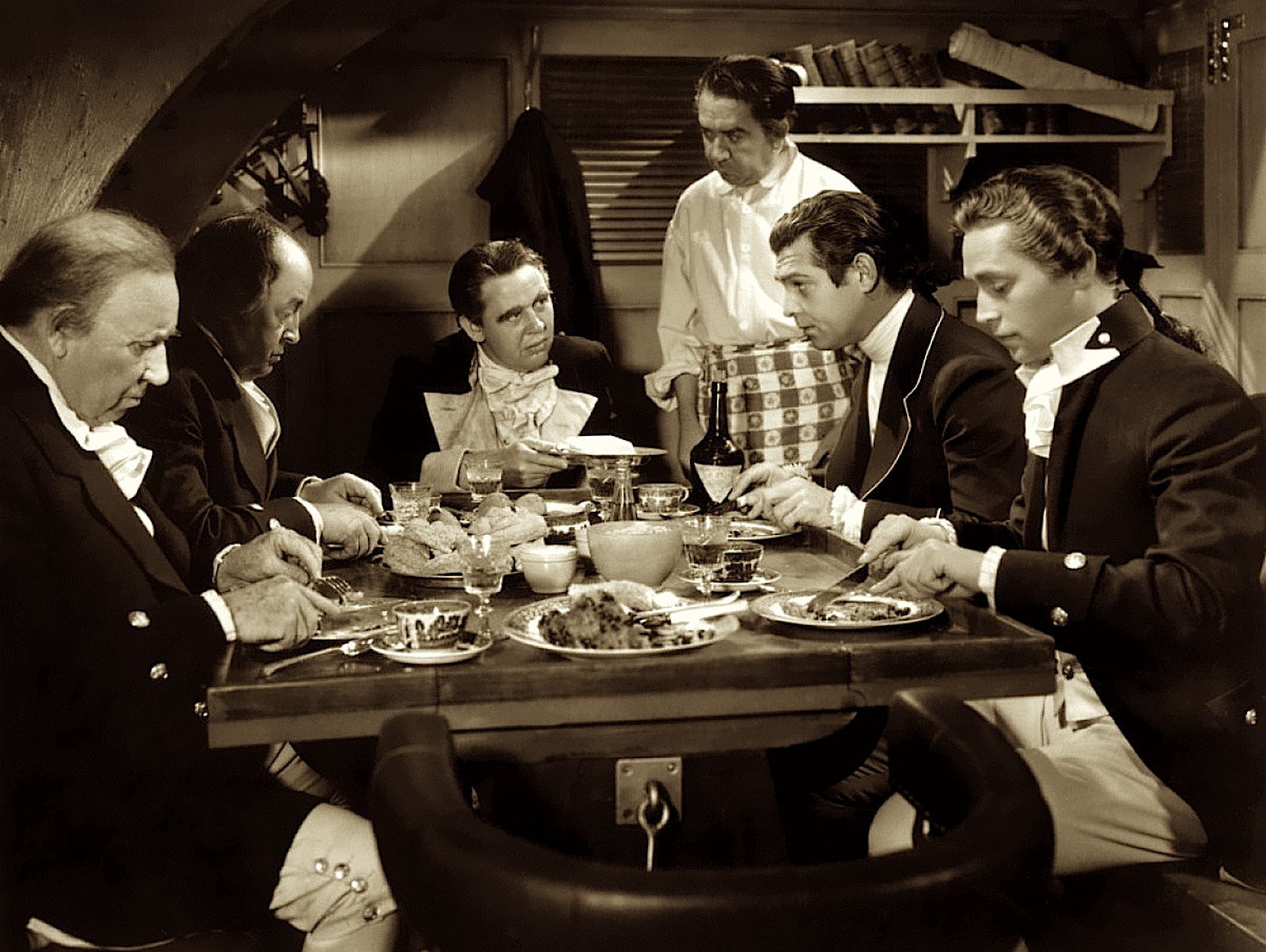
Charles
Laughton, Clark Gable and Franchot Tone in
"Mutiny on the Bounty" (1935)
ANNOUNCEMENT
Owing to Technical Difficulties the Virtual Gourmet is one day Late. My apologies
IN THIS ISSUE
DC POWER DINING
By John Mariani
NEW YORK CORNER
TWO GREAT NEW ETHNIC RESTAURANTS
ON THE UPPER WEST SIDE
By John Mariani
NOTES FROM THE WINE CELLAR
Two Nights Only: The "Best" Restaurant in the
World Goes On a World Tour
by Andrew Chalk
❖❖❖
DC POWER DINING
By John Mariani

It’s been said that dining out for a large segment of Washingtonians means subsisting on canapés and white wine at receptions, and that the city’s restaurants slow way down during those long and frequent Congressional recesses--like right now. Money, lobbyists and lawyers fuel the capital’s dining scene, even if our stalwart legislators can no longer accept more than a $25 meal from BP, the NRA, the AMA or the NFL. (The way lobbyists get around it is to have the congressman order the cheapest thing on the menu, then switch it with the more expensive dishes and wines the lobbyists order.)
 D.C.
restaurants, then, are highly dependent on the flow
of powerful people to keep them in the spotlight,
and pols and celebs do their best to oblige.
Indeed, after eight years when George and Laura Bush
rarely ventured out of the White House to dine, the
Obamas have made their presence felt consistently,
celebrating their anniversary at the Blue Duck Tavern
(left) in
the Park Hyatt Hotel, Mother’s Day at the Italian Ristorante Tosca,
and the First Lady’s birthday at Equinox, this
last also a favorite of Jill Biden and Hillary
Clinton.
D.C.
restaurants, then, are highly dependent on the flow
of powerful people to keep them in the spotlight,
and pols and celebs do their best to oblige.
Indeed, after eight years when George and Laura Bush
rarely ventured out of the White House to dine, the
Obamas have made their presence felt consistently,
celebrating their anniversary at the Blue Duck Tavern
(left) in
the Park Hyatt Hotel, Mother’s Day at the Italian Ristorante Tosca,
and the First Lady’s birthday at Equinox, this
last also a favorite of Jill Biden and Hillary
Clinton.
Indeed, Michelle Obama
eats out often with friends and official visitors,
frequenting the Indian restaurant Rasika,
José Andres’ Mexican restaurant Oyamel, and the
Creole/Cajun restaurant Acadiana,
which has also proven a magnet for show biz celebs
like Jay-Z, Beyoncé and Sean Combs, who come
here to dig into the fried green tomatoes, jambalaya
and fried catfish with grits.
Of course, there is always a
political element to entertaining dignitaries in
Washington, so when German Prime Minister
Andrea Merkle came to town, Obama took her to the
historic 1789 Restaurant
(below) in
Georgetown, which has strüdel on the menu and
gets it ducks from Hamburg, Pennsylvania.
Condoleezza Rice said her favorite restaurant was
the urbane (recently refurbished) Oval Room,
especially because it was just steps from the Oval
Office, where her boss, George W. Bush, stayed in,
eating creamed cheese sandwiches.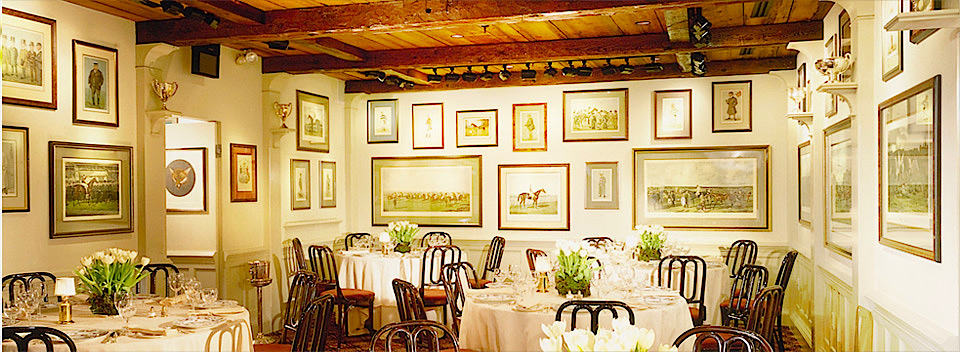
Before Bill Clinton got to the White House, Presidents and their wives chose restaurants that tended to be high-end French and exclusive, with names like Le Pavillon and the Polo Club--both Nancy Reagan’s favorites--while media honchos like Larry King claimed their special tables at steakhouses like Duke Ziebert’s and The Palm. In those days reporters like Woodward and Bernstein ate at their desks.
There are still some old-line restaurants near the Capitol and Union Station that draw legislators between debates and votes, like The Monocle, which opened in 1960 and has served every President since Kennedy and almost every Senator and Congressman. Owner Nick Valanos estimates that three-quarters of his customers “are people coming to the Hill to do business or to show friends or family what Washington is all about. They stop to see the photos on the wall, to experience some of the history that makes us unique. We’re usually booked six weeks out when Congress is in session.”
The Old Ebbitt Grill,
which dates back to 1856 and was once home to
William McKinley before he became president, is just
two blocks from the White House, and is still a
place local media hie to for oysters, beer and
gossip for tomorrow’s columns.
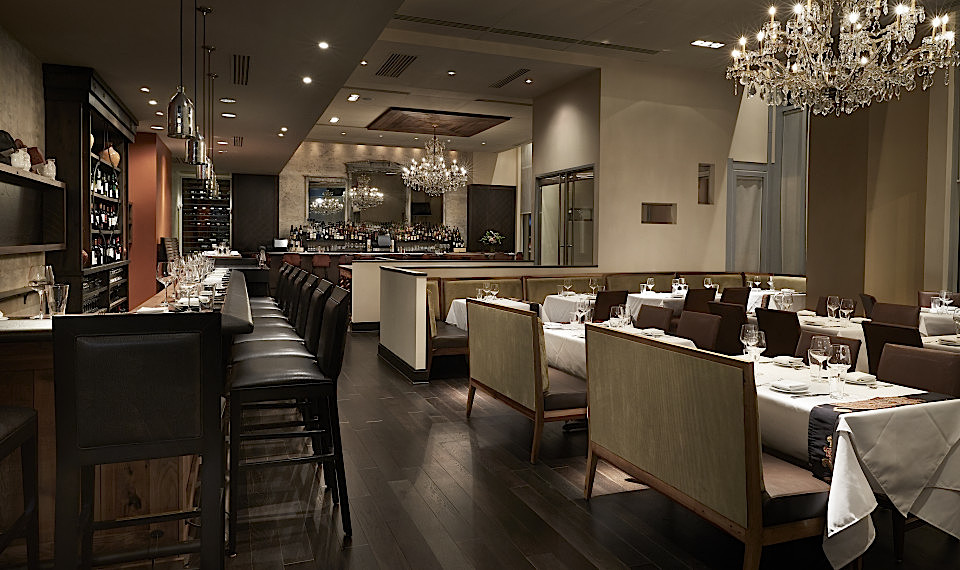 But these
days, restaurant entertaining in Washington is
geared to and driven by a far more inclusive, global
crowd. Italian-Americans like Supreme Court
Justice Antonin Scalia and former Secretary of
Homeland Security Janet Napolitano go for pasta to Al Dente,
whose location in the neighborhood called
Ambassadors Row draws a cross section of
internationals, along with media stars like “Meet
the Press” host David Gregory, ABC’s Gordon
Peterson, CBS’s Rita Braver and CNN’s Wolf Blitzer.
But these
days, restaurant entertaining in Washington is
geared to and driven by a far more inclusive, global
crowd. Italian-Americans like Supreme Court
Justice Antonin Scalia and former Secretary of
Homeland Security Janet Napolitano go for pasta to Al Dente,
whose location in the neighborhood called
Ambassadors Row draws a cross section of
internationals, along with media stars like “Meet
the Press” host David Gregory, ABC’s Gordon
Peterson, CBS’s Rita Braver and CNN’s Wolf Blitzer.
Young Washington interns and lobbyists take up the community tables at the Middle Eastern restaurant Zatinya, a big space with 200 seats and 50 at the bar, and the hot new Del Campo (left), serving Peruvian grilled food, which has drawn Mrs. Obama, comedian Chelsea Handler, and Bob and Elizabeth Dole.
Of course, Washington
would not be a crucible of secrets and intrigue if
it didn't have places the high and mighty meet with
the understanding that the public will not be at the
next table, where the Secret Service and bodyguards
sit. For this reason, private dining rooms in D.C.
hotels work well for complete discretion. When Obama
wanted to raise funds for his re-election, he
collected $8.5 million from financia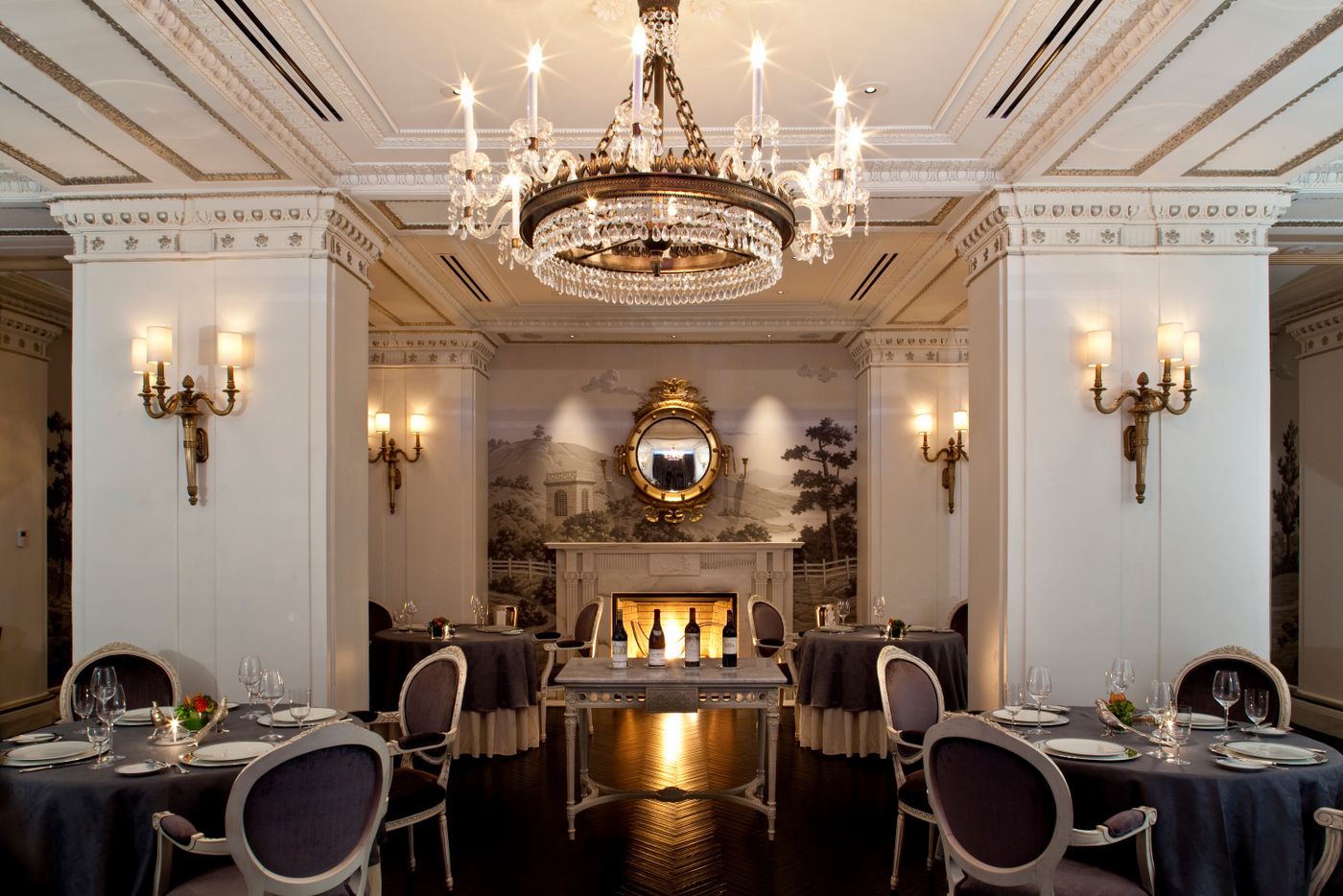 l backers at
private lunches held down in the wine cellar at Plume at
The Jefferson Hotel (right), whose clientele also
includes Bill Cosby, Joan Rivers and Martha Stewart.
l backers at
private lunches held down in the wine cellar at Plume at
The Jefferson Hotel (right), whose clientele also
includes Bill Cosby, Joan Rivers and Martha Stewart.
Indeed,
the management of the new Capella
Hotel in Georgetown refuses comment
on any politicians or celebrities who stay or dine
there. Still, on any given night at Bourbon Steak
on the lower level of the Four Seasons
Georgetown, you’ll find a sure number of pols,
foreign ambassadors, generals, and lobbyists who
might well be on the front page of tomorrow’s
papers. Or CNN tonight. Of course, in
Washington, what they all eat and drink is not
nearly as important as with whom they eat and drink
it, and who ends up paying the check.
Photo by Stirling Elmendorf
This article first
appeared in the NY
Post.
❖❖❖
TWO GREAT NEW ETHNIC RESTAURANTS
ON THE UPPER WEST SIDE
By John Mariani
Walk up or down any avenue on the Upper West Side and you will be astonished at the number of small restaurants of every ethnic stripe right next to each other. Indeed, it’s tough to find a dry cleaners or nail salon wedged in between them all, and, if I lived on the Upper West Side, I’d go crazy trying to choose what kind of food I wanted to eat.
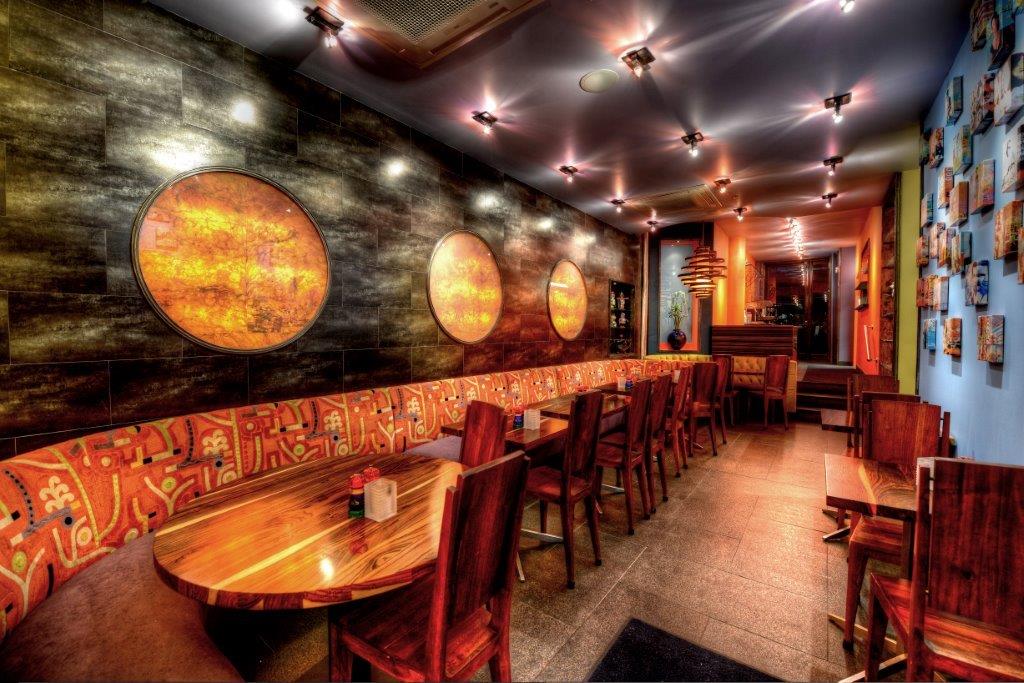 Two
outstanding newcomers to the neighborhood prove yet
again that many in the food media, who never seem to
venture above the Bowery or beyond Greenpoint, have
demeaned the UWS’s restaurant offerings by sheer
omission.
Bustan (left),
a Mediterranean restaurant with an Israeli chef, and
Awadh, which
features the cooking of that northeastern region of
India, both diverge from other restaurants in
significant ways. Both also show that, unlike so
many of their competitors up and down the block,
there is a sure degree of professional pride in the
management of the places, instead of the
lackadaisical and robotic rote you find far too
often.
Two
outstanding newcomers to the neighborhood prove yet
again that many in the food media, who never seem to
venture above the Bowery or beyond Greenpoint, have
demeaned the UWS’s restaurant offerings by sheer
omission.
Bustan (left),
a Mediterranean restaurant with an Israeli chef, and
Awadh, which
features the cooking of that northeastern region of
India, both diverge from other restaurants in
significant ways. Both also show that, unlike so
many of their competitors up and down the block,
there is a sure degree of professional pride in the
management of the places, instead of the
lackadaisical and robotic rote you find far too
often.
Bustan, which means garden, is clearly a labor of love for proprietor Tuvia Feldman, executive chef/partner Efi Nahon and general manager/partner Guy Goldstein, who are committed to showing the extraordinary depth and breadth of the food cultures that hug the shores of the Mediterranean. So, you’ll taste the intertwined flavors of North Africa, Italy, Greece and the Middle East from a long menu, from mezes to flatbreads, and many dishes are cooked in a dome shaped, wood-fired taboon oven. Goldstein has assembled a small estate wine list that is exceptional for small restaurants of this stripe.
The 74-seat room
and outdoor patio blend sea colors with earth tones,
with a charcoal-colored faux stone wall backlit with
portholes. At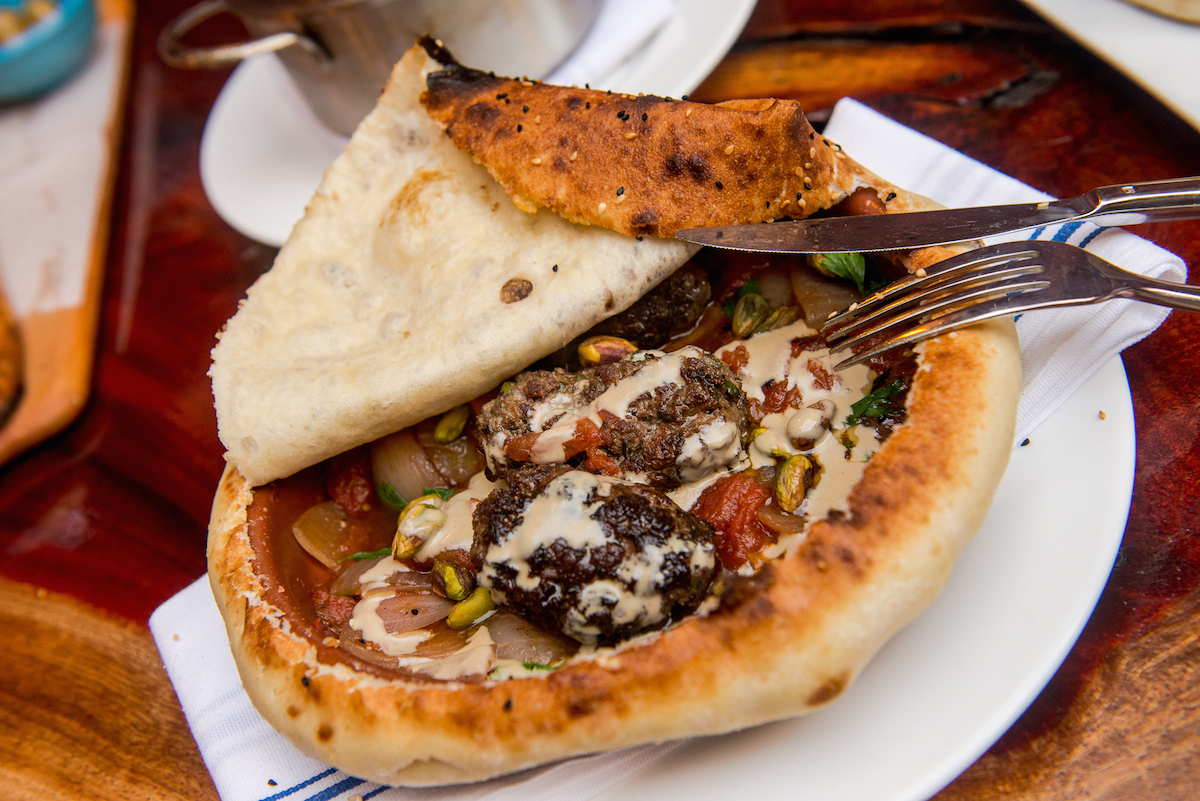 the moment,
the garden out back is in full swing and highly
desirable.
the moment,
the garden out back is in full swing and highly
desirable.
Our table of four ate extensively from the menu, starting with an array of mezes ($6-$19), or mazettim, that included luscious hummus with lamb kebob and shredded beef cheeks. Charred octopus ($18) with warm white bean masabaha, crushed tomatoes, green harissa and botargo roe was a lot of good food on one small plate, while Moroccan lentil soup ($9.95) was
riddled with delicious lamb merguez sausage and root vegetables, with a lacing of cool yogurt.
Soft egg buttery, flaky burek pastry ($18) with creamed sunchokes, mushrooms and truffle oil is, I suspect, unique to New York, and the saganaki ($11.95) was well out of the ordinary, with efalograviera sheep’s milk cheese on fennel seeds with a roasted tomato compote.
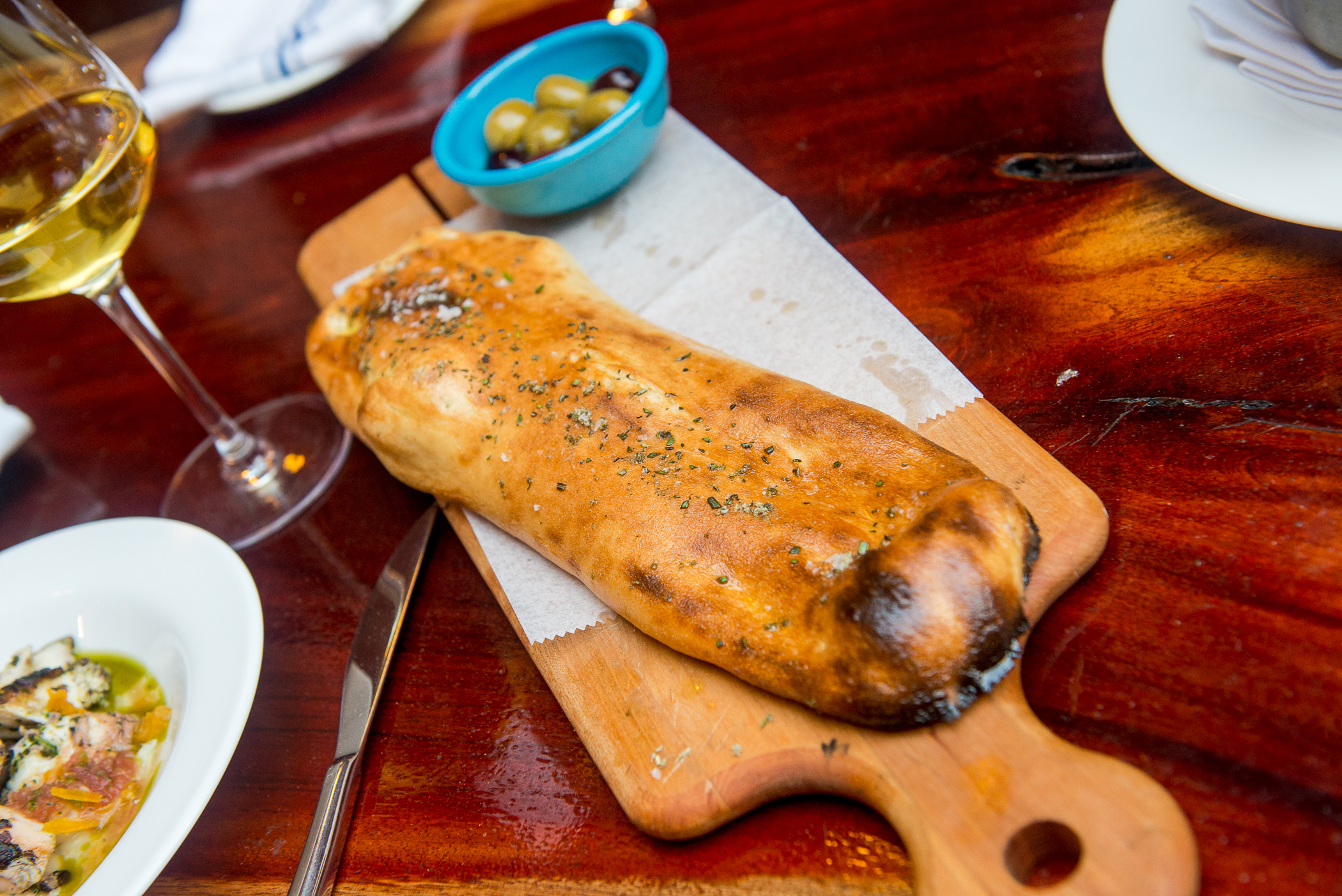 There
was so much more I loved: tender flatbreads with
cured tuna, zaatar,
red onion, feta, spinach and fresh tomato ($15);
spicy lamb terracotta (above), with grilled vegetables,
tahini and pistachio baked in flaky top crust; and
the Greek pastrami with parmesan and red peppers
($12) was sensationally good. All these I
would rush back for without hesitation, though I
would not for the only real dud in the menu:
tasteless roasted eggplant in coconut milk with a
curry-like seasoning called vodouvan.
I might add that if Bustan served nothing more than
its complimentary puffy bread (left), I would
wait outside to collect the day’s leftover loaves.
There
was so much more I loved: tender flatbreads with
cured tuna, zaatar,
red onion, feta, spinach and fresh tomato ($15);
spicy lamb terracotta (above), with grilled vegetables,
tahini and pistachio baked in flaky top crust; and
the Greek pastrami with parmesan and red peppers
($12) was sensationally good. All these I
would rush back for without hesitation, though I
would not for the only real dud in the menu:
tasteless roasted eggplant in coconut milk with a
curry-like seasoning called vodouvan.
I might add that if Bustan served nothing more than
its complimentary puffy bread (left), I would
wait outside to collect the day’s leftover loaves.
Desserts are well worth ordering, from shredded halvah ($8.95) with milk gelato, rice brittle and caramelized nuts to semolina and coconut cake ($8.95) with strawberry compote and yogurt-chestnut gelato.
Bustan is located at 487
Amsterdam Avenue (between 83rd and 84th Streets);
212-595-5050. Open for dinner nightly; Fri., Sat.
& Sun. for brunch.
There
are several Indian communities around New York, but
the Upper West Side is not one of them. What a
wondrous surprise, then, to find that the best
Indian restaurant in the city is up there, Awadh;
indeed, along with the superb Rasika in Washington,
I’d rank Awadh among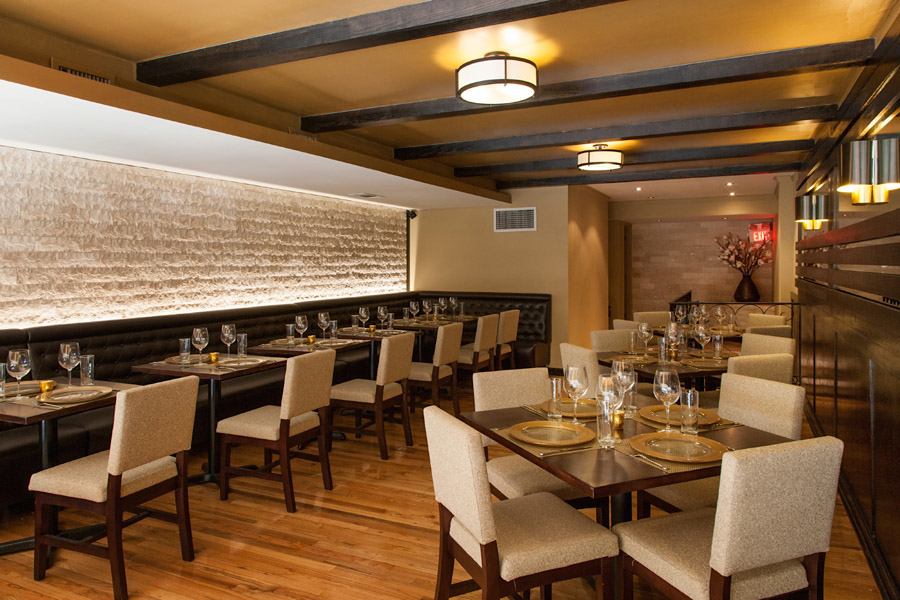 the finest
anywhere.
the finest
anywhere.
I say that with one caveat: almost everything I ordered was a specialty of the region of Awadh in Uttar Pradesh, whose rich cuisine and slow cooking methods were heavily influenced by well-spiced Mughal cooking. So, if you insist on ordering the Pan-Indian items on the menu, I’m sure you’ll be pleased but you would rob yourself of extraordinary dishes not found all over town.
I should not have been surprised that Awadh was go good, for its owner and chef is Gaurav Anand, whose Moti Mahal Delux and Bhatti Indian Grill, both on the East Side, have justified reputations for their refined cooking.
Awadh is a very
smart-looking restaurant, unusual among the
storefront eateries on the UWS. It’s set on
two floors, the first with a double-height glass
façade, an 8-foot chrome and cascading bubble
glass chandelier, dark wood paneling, gold pendant
lights, exposed wood beams and gold foil wallpaper
setting the tone for a cozy yet refined atmosphere.
The second floor (right) is a
bit more reserved and happily less noisy, with
tufted banquettes and textured stone
walls.
Photo by Maike Paul
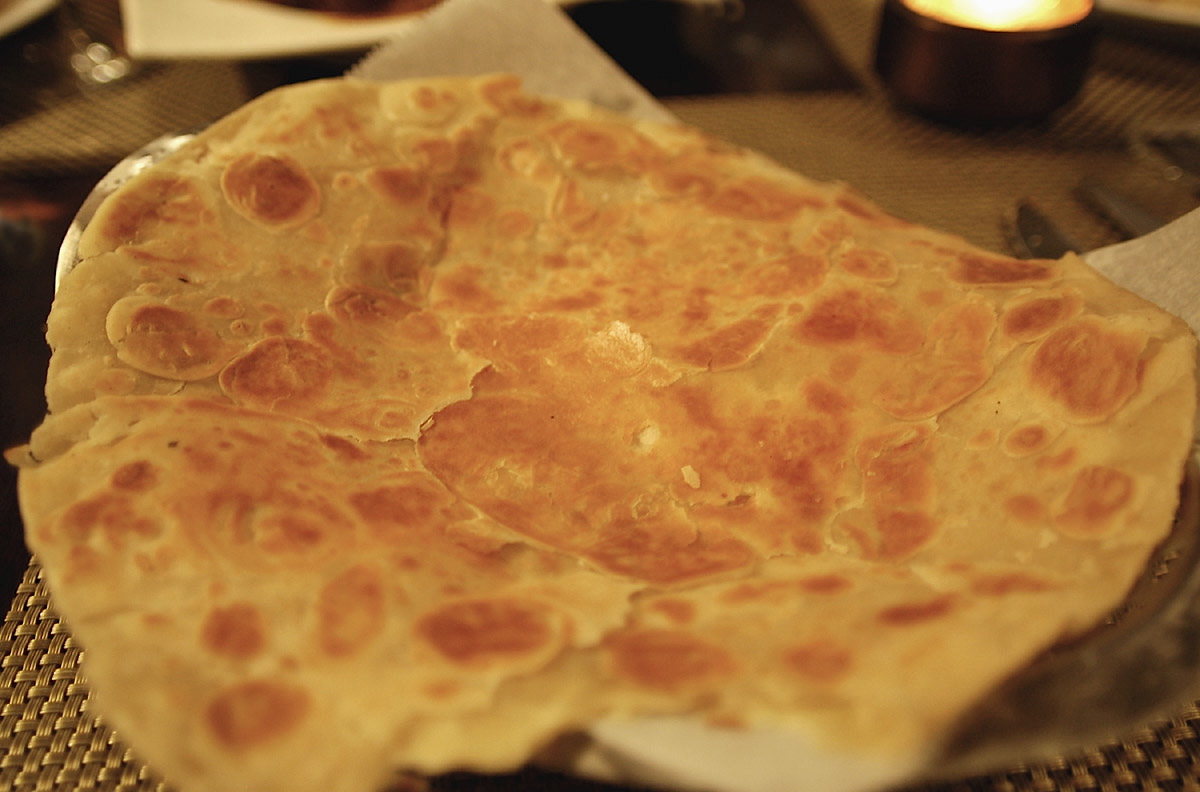 Sommelier
John Slover shows that Indian food need not be
distanced from the subtleties of good wine, and
there are spiced and herbal cocktails offered, along
with an impressive array of teas.
Sommelier
John Slover shows that Indian food need not be
distanced from the subtleties of good wine, and
there are spiced and herbal cocktails offered, along
with an impressive array of teas.
Before even
getting to the menu, I must comment on one of the
most delicious breads I’ve ever had in my
life. It’s called ulta tawa parantha (left) and is
thin, very flaky and cooked with ghee butter in
a wok, resulting in a pattern of flattened bubbles
that add texture. I even broke Indian
tradition to eat it before the man courses because I
could not resist.
Photo by Michael Tulipan
We
began noshing on crispy okra called karari bhindi ($8),
then, very hungry by then, a marinated and grilled
chicken dish called murgh tikka with sweet-and-sour
pomegranate ($10) and succulent galouti kebabs
($11) of spiced mint lamb patties.
Mustard-coated and marinated lamb chops called chaap ka barrah
($14) had decent flavor but the coating made the
lamb steamy, which was not a problem with grilled
sizzling jumbo prawns in a carom seed marinade,
called ajwaini
jheenga ($12).
Our main courses
included wonderfully aromatic nali ki nihari I
(below), a hefty lamb shank ($18) simmered
overnight to absorb tremendous flavor.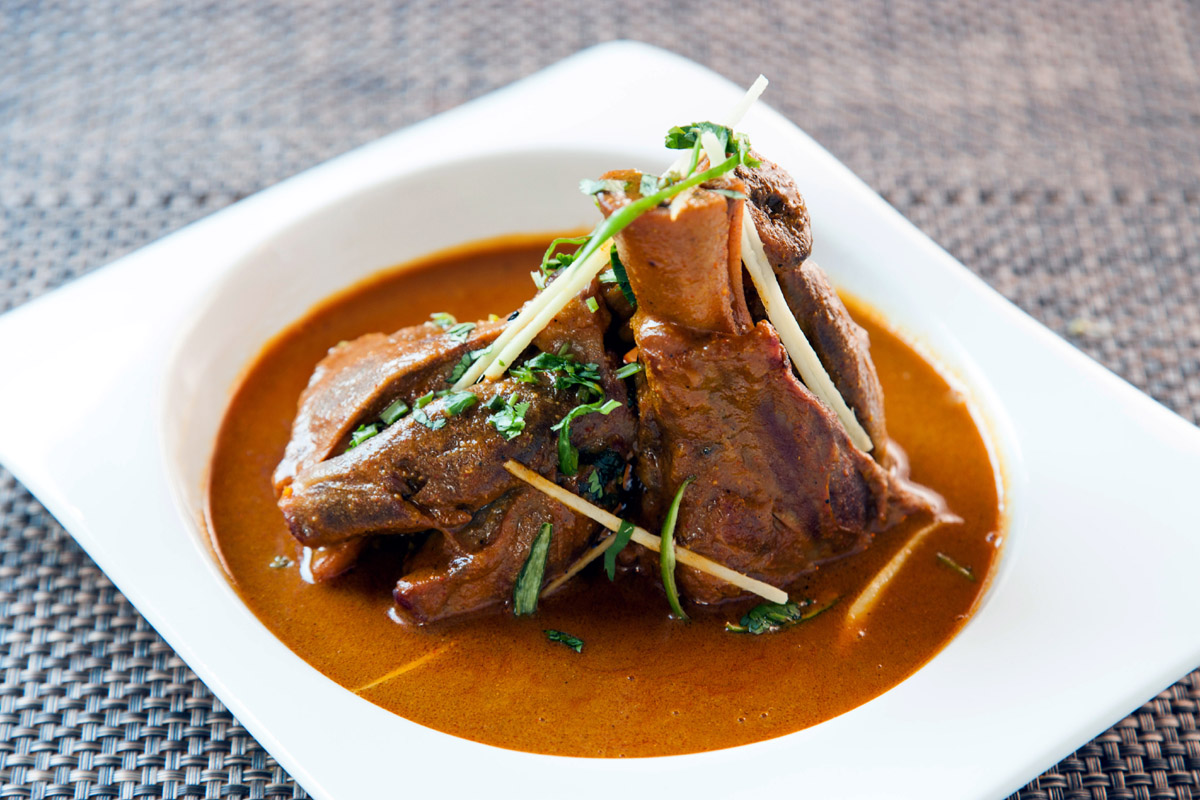 The famous
butter chicken called makhanwala was created at Moti
Mahal ($16) and now everyone does it, but none
better than Mr. Anand, who brought it cross town to
Awahd. Steamed basmati rice came with a savory
lamb stew ($16).
The famous
butter chicken called makhanwala was created at Moti
Mahal ($16) and now everyone does it, but none
better than Mr. Anand, who brought it cross town to
Awahd. Steamed basmati rice came with a savory
lamb stew ($16).
Indian cooks too often dry out their fish with cooking or, just as bad, overspice it. At Awadh, mahi musallam ($21) is a whole fish coated with spices like turmeric that pack their punch but give way to a juicy,flavorful whole fish that is an exemplar of what careful attention to detail can accomplish.
Too few Indian kitchens pay much attention to desserts, often buying them elsewhere and bringing them in to sit in the refrigerator. Awadh’s are made fresh and have both subtly and fragrance, from the phirni rice pudding with cardamom ($7) to the kulfi creamy “Popsicle”($8) and some very intense flavorful sorbets of peach, raspberry and coconut ($8).
I’ve every reason
to believe that the rest of Awadh’s menu lives up to
its Uttar Pradesh specialties, but if you go,
promise me you will focus on the latter. And tell me
how the rest is. I’m dying to go back and find
out.
Photo by Maike Paul
Awadh
is located at 2588 Broadway (between97th and 98th
Streets); 646-861-3604. Dinner daily; Lunch
Monday-Friday;Brunch Saturday & Sunday 12-3 p.m.
❖❖❖
By Dotty Griffith
 In my
experience, “tilapia” has always been the English
translation of the Piscean word for “flaccid
fish.” Mushy, tasteless, not even a particularly
able canvass for flavors and techniques that other
fish – red snapper, sole, cod, sea bass even
catfish – showcase so much better. Imagine
my surprise when I found myself loving tilapia at
Galei Gil
restaurant (left)
in Tiberias, Israel, an ancient town on the shore
of the Sea (understand it’s a freshwater lake) of
Galilee.
In my
experience, “tilapia” has always been the English
translation of the Piscean word for “flaccid
fish.” Mushy, tasteless, not even a particularly
able canvass for flavors and techniques that other
fish – red snapper, sole, cod, sea bass even
catfish – showcase so much better. Imagine
my surprise when I found myself loving tilapia at
Galei Gil
restaurant (left)
in Tiberias, Israel, an ancient town on the shore
of the Sea (understand it’s a freshwater lake) of
Galilee.
Every bistro menu on the lakeside
promenade overlooking the storied body of water
touts its specialty: St. Peter’s fish. So does my
Frommer’s
Guide, explaining that the fish, also known
locally as musht,
was in St. Peter’s net when he was tapped by Jesus
to change jobs and become a fisher of men instead
of musht. I
adore the irony of the pronunciation: “mush-ty.”
Don’t tell me otherwise and spoil it.
Whole, butterflied with head on, then
grilled, St. Peter’s fish at Galei Gil, served
with roast potatoes and lemon sauce, was
delightful, full of flavor. Yes, with bones, but
that’s where the flavor comes from. And from the
skin and the head. Of course, the legend and the
setting also enhanced the plate. When I ate it, of
course, I had no idea I was eating tilapia.
I also found out that St. Peter’s Fish,
also dubbed Saint-Pierre, poule de mer and
dorée (France , John Dory Britain),
Christópsaros (Greece), hout sidi Tunisia),
dülger (Turkish), gall (Catalonia) and
kovaç (Serbia), was introduced to the Sea of
Galilee in the 1930s by a kibbutz. Seemed to me
this was more than an editing oversight or a
theological dispute. So I turned to the ultimate
authority: Google. Imagine my surprise when I
learned that St. Peter’s fish aka musht is
tilapia, the most insipid fish on American menus!
(Though
the average American eats only a pound and a half
of it each year.)
The disparities can be
reconciled. After all, musht, aka St. Peter’s fish
aka tilapia, has been a food fish in the Nile and
the Near East for thousands of years, way BC. And
the species has been released into the Sea of
Galilee many times to remedy overfishing. Clarify
your text and call the Sea of Galilee specialty a
St. Peter’s fish, a musht,
and a tilapia.
And will somebody please sell me
a whole tilapia instead of a twice or thrice
frozen fillet that thaws to mush? I can’t believe
I had to go to Israel to find meaty, toothsome and
full-flavored tilapia.
❖❖❖
 NOTES
FROM THE WINE CELLAR
NOTES
FROM THE WINE CELLARTwo Nights Only: The
"Best" Restaurant in the
World Goes On a World Tour
by Andrew Chalk
El Celler de Can
Roca has three Michelin stars and the
title of 2013 Best Restaurant in the World from Restaurant
Magazine (it slipped to second in 2014, but nobody
is declaring statistical significance behind
that). Normally, the restaurant is the pride of
Girona, in Spain’s beautiful Catalonia
region. However, last month it was closed, and its
three owners--Joan and Josep Roca and Monserrat
Fontané, and 24 of their staff have
become the world’s most famous pop-up restaurant,
appearing in Houston, Dallas, Monterrey, Mexico
City, Bogota and Lima. Supplies are being sourced
locally at each stop.
The sponsor and underwriter of this spectacle
is BBVA, the Spanish bank that has a major presence
in these markets. They operate as BBVA Compass in the U.S. and
are the fourth largest bank, by deposits, in Texas.
These dinners are being offered to BBVA clients, and
will contribute a deeper understanding of the finest
examples of the culture of Spain. Additionally, BBVA
Compass will fund a four-month scholarship for two
culinary students attending Le Cordon Bleu College
of Culinary Arts in Dallas in the kitchens of El
Celler de Can Roca next year in what has to be one
of the most outstanding staging opportunities
available to a trainee chef today.
Compass in the U.S. and
are the fourth largest bank, by deposits, in Texas.
These dinners are being offered to BBVA clients, and
will contribute a deeper understanding of the finest
examples of the culture of Spain. Additionally, BBVA
Compass will fund a four-month scholarship for two
culinary students attending Le Cordon Bleu College
of Culinary Arts in Dallas in the kitchens of El
Celler de Can Roca next year in what has to be one
of the most outstanding staging opportunities
available to a trainee chef today.
The Dallas dinner also gave Dallas diners a
chance to decide whether to make reservations at El
Celler de Can Roca in Girona. I will jump ahead and
say that the answer is a categorical ‘yes’. Act now.
It was my meal of the year (thus far) and it was
also refreshing to see the perimeter of culinary
accomplishment after being neck-deep in the interior
for 99% of the time.
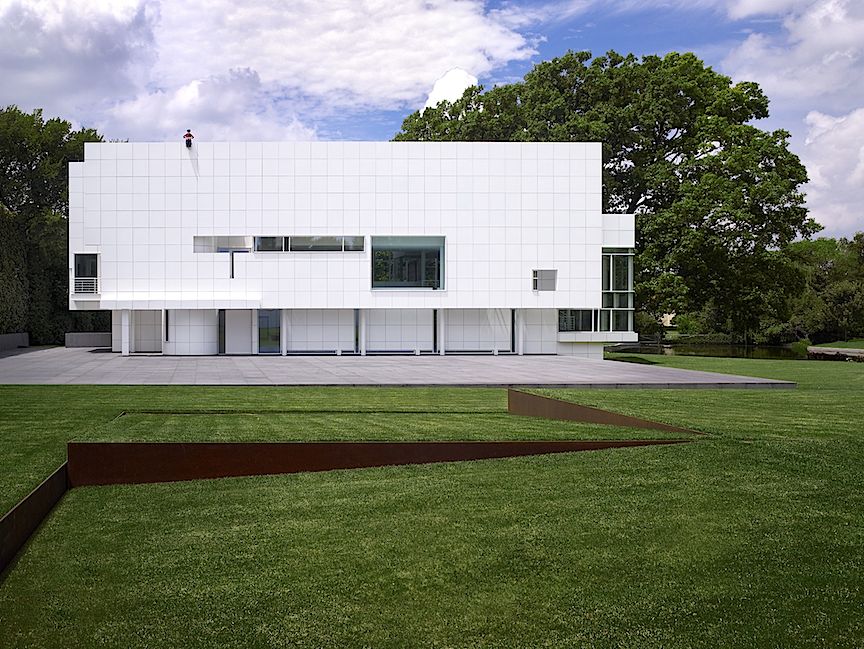 The
setting cannot have been more appropriate. The
starkly dramatic Rachofky
House in Dallas’ Preston Hollow, belonging to
Dallas art patrons Cindy and Howard Rachofsky,
stands as a museum of contemporary art in its own
right. It even has its own web site. The 100 guests
were truly eating art, amid art.
The
setting cannot have been more appropriate. The
starkly dramatic Rachofky
House in Dallas’ Preston Hollow, belonging to
Dallas art patrons Cindy and Howard Rachofsky,
stands as a museum of contemporary art in its own
right. It even has its own web site. The 100 guests
were truly eating art, amid art.
The meal started with a visual stunner. ‘El
Mundo’, an upturned log serving as the base for five
morsels each representing stops on the tour. There
was a piccolo-sized
corn taquito
with mole
representing Mexico City. These bite-sized tacos
will catch on if someone can figure out how to make
them without involving the culinary dexterity of a
three-star chef. Monterrey got green tomato with
guacamole and coriander. Lima got its causa,
replete with the black olives in powdered form
sprinkled over the potato mash. Bogota got a
Colombian basket of peanuts, nougat-like guirlache,
coconut cream, lime gel, coffee, jelly, peanuts,
nutty caramel and cider.
Dallas and Houston got a riff on barbecue.
A sweet corn fritter filled with barbecue
spicy sauce. Each one was but a mouthful but a memorable appetizer to
start the meal. How should chicken tinga
taste look and taste? How about like an orb, based
on modernist techniques of spherification caviar,
ready to burst in the mouth with flavors of chicken,
chilies and smoke. A single example was served on a
dessert spoon, to much audience appreciation.
a memorable appetizer to
start the meal. How should chicken tinga
taste look and taste? How about like an orb, based
on modernist techniques of spherification caviar,
ready to burst in the mouth with flavors of chicken,
chilies and smoke. A single example was served on a
dessert spoon, to much audience appreciation.
It
was a balmy 102⁰
outside, so gazpacho really hit the spot. The
refreshing soup was dotted with contrasting chunks
of watermelon. In the center an island of refried
beans supported a succulent panko-fried oyster.
Great flavors and textures for a hot summer’s day. A
Leonor
12-year old Palo Cortado, Sherry served as
refined liquid accompaniment.
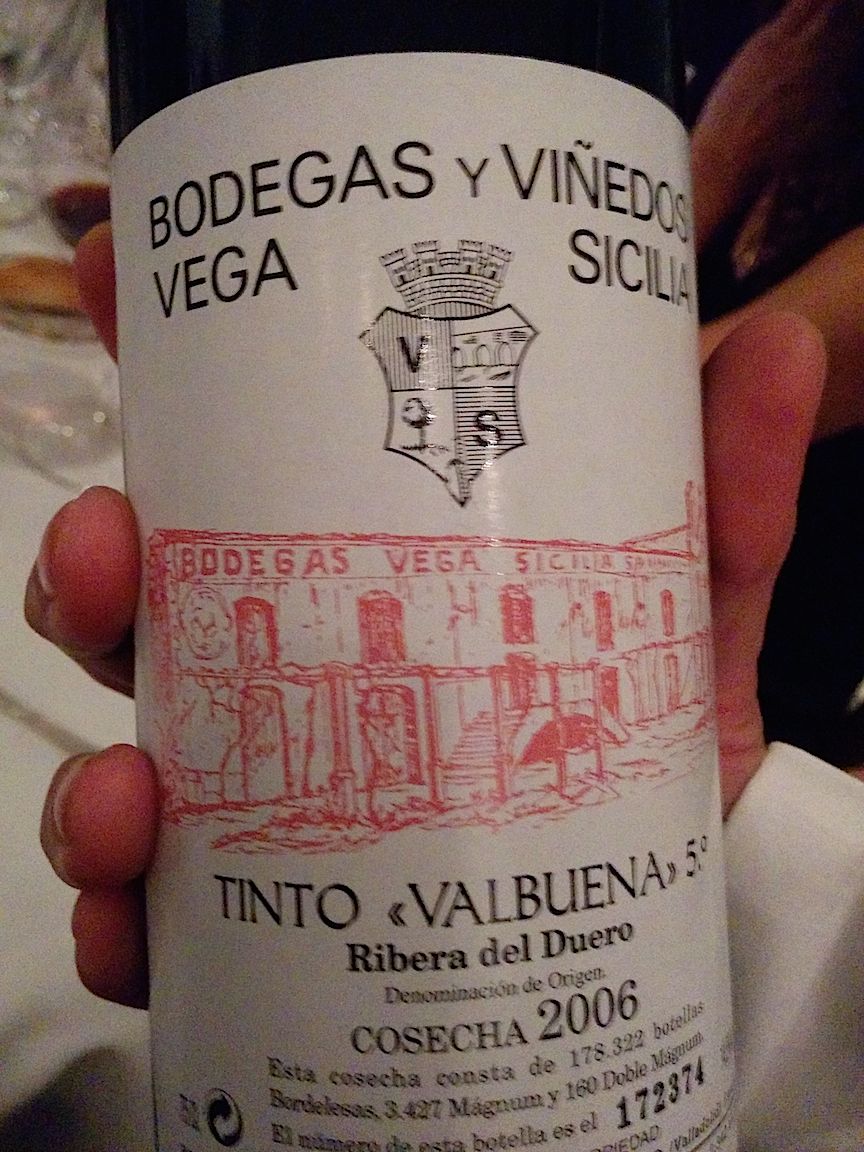 I
must have had suckling pig a dozen times in Spain
alone. But never have I found such an exact harmony
between the crisp, roasted skin and the limpid,
oozing meat inside than this preparation by El
Celler de Can Roca. The skin submitted like a fresh
wafer to the bite and every fiber of the enclosed
meat exuded earthy flavors as if by command.
I
must have had suckling pig a dozen times in Spain
alone. But never have I found such an exact harmony
between the crisp, roasted skin and the limpid,
oozing meat inside than this preparation by El
Celler de Can Roca. The skin submitted like a fresh
wafer to the bite and every fiber of the enclosed
meat exuded earthy flavors as if by command.
I
should say that the 1987 Torres
Mas la Plana was the perfect partner. It was!
But that would detract from the singular joy of
these two great foodstuffs of the western world
being revered in solitary isolation. The Mas la
Plana was a wine at its peak. Ripe fruit embraced in
cedar effusing cigar box aromas all framed with
fully resolved tannins.
Another
highlight was veal shank which, I suspect, was
cooked sous vide. It was cut-with-a-fork tender and
rivetingly exciting with all those African and Asian
spices in the mix. In an apparent nod to the idea of
exceeding one’s own best efforts, the 2006 Vega
Sicilia ‘Valbuena,’ a 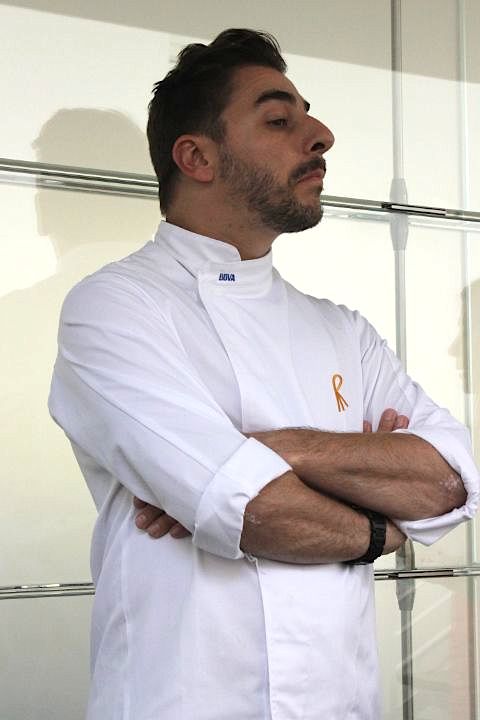 Tempranillo Merlot blend
from the Ribera del Duero, the second wine of the
Spain’s most famous winery, was an excellent match,
and a young eight years old.
Tempranillo Merlot blend
from the Ribera del Duero, the second wine of the
Spain’s most famous winery, was an excellent match,
and a young eight years old.
Jordi Roca (right) is in
charge of the desserts at El Celler de Can Roca. He
excelled with two desserts on this occasion. The dulce de leche
was rich, but light enough to be completely
finished, despite thirteen preceding courses.
El Celler de can Roca is a very special
restaurant and very special restaurants tend to fill
up early. This world tour will only burnish their
three Michelin stars still more so I urge all
serious gourmands to reserve now if they plan to
visit Spain in the next year.
AS HIP AND COOL AND POP CULTURE SAVVY
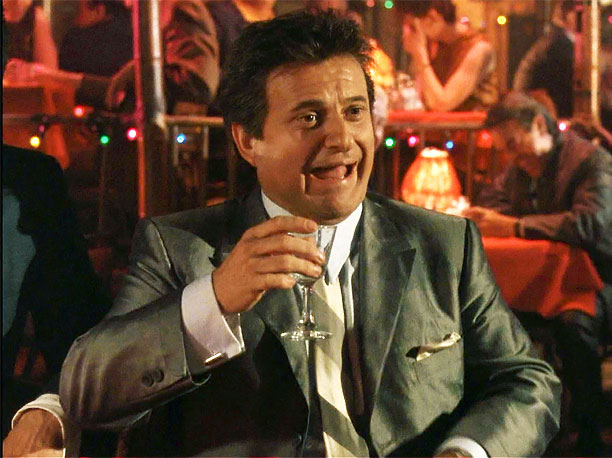
AS WE ARE, WE DON'T UNDERSTAND A WORD OF THIS
"For years, East 6th Street has gotten a particularly
bad rap,
pigeonholed like some Bollywood
Joe
Pesci as a culinary minefield of sporadic Desi
Treats."--
Zachary Feldman, "The Eddy in the East Village Focuses
on Small Plates and Gussied-Up Booze," Village Voice
(7/9/14)
 HE'S PLEADING
THE OSCAR PISTORIUS DEFENSE
HE'S PLEADING
THE OSCAR PISTORIUS DEFENSE
After a Decatur, IL, woman consumed three Chips Ahoy
cookies belonging to her roommate, Allen Hall, thereupon
allegedly tried
to kill her for devouring his treat, police said.
The victim apparently thought Hall was joking when he
pounded on the bathroom door and threatened to kill her.
Any of John Mariani's
books below may be ordered from amazon.com.
 |
The Encyclopedia of American Food and Drink by John F. Mariani (Bloomsbury USA, $35) Modesty forbids me to praise my own new book, but let me proudly say that it is an extensive revision of the 4th edition that appeared more than a decade ago, before locavores, molecular cuisine, modernist cuisine, the Food Network and so much more, now included. Word origins have been completely updated, as have per capita consumption and production stats. Most important, for the first time since publication in the 1980s, the book includes more than 100 biographies of Americans who have changed the way we cook, eat and drink -- from Fannie Farmer and Julia Child to Robert Mondavi and Thomas Keller. "This book is amazing! It has entries for everything from `abalone' to `zwieback,' plus more than 500 recipes for classic American dishes and drinks."--Devra First, The Boston Globe. "Much needed in any kitchen library."--Bon Appetit. |
"Eating Italian will never be the same after reading John Mariani's entertaining and savory gastronomical history of the cuisine of Italy and how it won over appetites worldwide. . . . This book is such a tasteful narrative that it will literally make you hungry for Italian food and arouse your appetite for gastronomical history."--Don Oldenburg, USA Today. "Italian
restaurants--some good, some glitzy--far
outnumber their French rivals. Many of
these establishments are zestfully described
in How Italian Food Conquered the World, an
entertaining and fact-filled chronicle by
food-and-wine correspondent John F.
Mariani."--Aram Bakshian Jr., Wall Street
Journal.
"Equal parts
history, sociology, gastronomy, and just
plain fun, How Italian Food Conquered the
World tells the captivating and delicious
story of the (let's face it) everybody's
favorite cuisine with clarity, verve and
more than one surprise."--Colman Andrews,
editorial director of The Daily
Meal.com. "A fantastic and fascinating
read, covering everything from the influence
of Venice's spice trade to the impact of
Italian immigrants in America and the
evolution of alta cucina. This book will
serve as a terrific resource to anyone
interested in the real story of Italian
food."--Mary Ann Esposito, host of PBS-TV's
Ciao
Italia. "John Mariani has written the
definitive history of how Italians won their
way into our hearts, minds, and
stomachs. It's a story of pleasure over
pomp and taste over technique."--Danny Meyer,
owner of NYC restaurants Union Square
Cafe, The Modern, and Maialino.
|
 |
 |
 |
 |
 |
 |
 |
 |
 Everett Potter's Travel Report:
Everett Potter's Travel Report: 
 Eating Las Vegas
is the new on-line site for Virtual Gourmet
contributor John A. Curtas., who since 1995
has been commenting on the Las Vegas food
scene and reviewing restaurants for Nevada
Public Radio. He is also the
restaurant critic for KLAS TV, Channel 8 in
Las Vegas, and his past reviews can be
accessed at KNPR.org.
Click on the logo below to go directly to
his site.
Eating Las Vegas
is the new on-line site for Virtual Gourmet
contributor John A. Curtas., who since 1995
has been commenting on the Las Vegas food
scene and reviewing restaurants for Nevada
Public Radio. He is also the
restaurant critic for KLAS TV, Channel 8 in
Las Vegas, and his past reviews can be
accessed at KNPR.org.
Click on the logo below to go directly to
his site.

Tennis Resorts Online: A Critical Guide to the World's Best Tennis Resorts and Tennis Camps, published by ROGER COX, who has spent more than two decades writing about tennis travel, including a 17-year stretch for Tennis magazine. He has also written for Arthur Frommer's Budget Travel, New York Magazine, Travel & Leisure, Esquire, Money, USTA Magazine, Men's Journal, and The Robb Report. He has authored two books-The World's Best Tennis Vacations (Stephen Greene Press/Viking Penguin, 1990) and The Best Places to Stay in the Rockies (Houghton Mifflin, 1992 & 1994), and the Melbourne (Australia) chapter to the Wall Street Journal Business Guide to Cities of the Pacific Rim (Fodor's Travel Guides, 1991).


MARIANI'S VIRTUAL GOURMET
NEWSLETTER is published weekly. Editor/Publisher: John
Mariani.
Editor: Walter Bagley. Contributing Writers: Christopher Mariani,
Robert Mariani, Misha
Mariani, John A. Curtas, Edward Brivio, Mort
Hochstein, Andrew Chalk, Dotty Griffith and Brian Freedman. Contributing
Photographers: Galina Dargery, Bobby
Pirillo. Technical Advisor: Gerry McLoughlin.
To un-subscribe from this newsletter,click here.
© copyright John Mariani 2014
